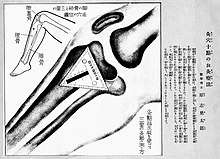Zusanli
Zusanli (Chinese: 足三里, ST36) is an acupoint, a point of the skin that is stimulated, with various techniques, in the practice of acupuncture. It is located below the knee, on the tibialis anterior muscle, along the stomach meridian.

Therapeutic uses and scientific validation
Acupuncture of Zusanli induces local serotonin release.[1] Furthermore, the stimulation of this acupoint is shown to decrease inflammation, as evidenced by decreased cytokines (including interleukin 6) and inhibition of edema in a rat model of inflammation involving carrageenan injection.[2] Zusanli activation also improves insulin sensitivity [3] and cerebral blood flow (an effect mediated by nitric oxide),[4] while it decreases sympathetic nerve activity and arterial pressure.[5] An analgesic effect, mediated in part by nitric oxide as well, through the upregulation of inducible nitric oxide synthase (iNOS),[6] an increase in endogenous opiates,[7][8] muscarinic cholinergic receptors and serotonin receptors 5-HT1a and 5-HT3, was repeatedly evidenced.
The stimulation of Zusanli decreases the locomotor activity elicited by nicotine administration and decreases Fos-like immunoreactivity in the basal ganglia (e.g., the striatum, particularly the nucleus accumbens) in a rat model of nicotine sensitisation.[9] Those changes in the basal ganglia also improve the alcohol withdrawal syndrome in similar experimental conditions.[10]
See also
References
- Dimitrov, N; Atanasova, D; Tomov, N; Sivrev, D; Lazarov, N (2017). "Acupuncture causes serotonin release by mast cells". Romanian Journal of Morphology and Embryology. 58 (3): 961–968. PMID 29250675.
- Chae Y, Hong MS, Kim GH, et al. (2007). "Protein array analysis of cytokine levels on the action of acupuncture in carrageenan-induced inflammation". Neurol. Res. 29 Suppl 1: S55–8. doi:10.1179/016164107X172365. PMID 17359642.
- Chang SL, Lin KJ, Lin RT, Hung PH, Lin JG, Cheng JT (2006). "Enhanced insulin sensitivity using electroacupuncture on bilateral Zusanli acupoints (ST 36) in rats". Life Sci. 79 (10): 967–71. doi:10.1016/j.lfs.2006.05.005. PMID 16762373.
- Hsieh CL, Chang QY, Lin IH, et al. (2006). "The study of electroacupuncture on cerebral blood flow in rats with and without cerebral ischemia". Am. J. Chin. Med. 34 (2): 351–61. doi:10.1142/S0192415X06003886. PMID 16552844.
- Michikami D, Kamiya A, Kawada T, et al. (2006). "Short-term electroacupuncture at Zusanli resets the arterial baroreflex neural arc toward lower sympathetic nerve activity". Am. J. Physiol. Heart Circ. Physiol. 291 (1): H318–26. doi:10.1152/ajpheart.00975.2005. PMID 16501021.
- Kim EH, Park HJ, Lee H, et al. (2007). "Analgesic effects by electroacupuncture were decreased in inducible nitric oxide synthase knockout mice". Neurol. Res. 29 Suppl 1: S28–31. doi:10.1179/016164107X172257. PMID 17359637.
- Kim SK, Moon HJ, Na HS, et al. (2006). "The analgesic effects of automatically controlled rotating acupuncture in rats: mediation by endogenous opioid system". The Journal of Physiological Sciences. 56 (3): 259–62. doi:10.2170/physiolsci.SC002706. PMID 16839460.
- Jung JY, Yang HR, Jeong YJ, et al. (2006). "Effects of acupuncture on c-Fos expression in brain after noxious tooth stimulation of the rat". Am. J. Chin. Med. 34 (6): 989–1003. doi:10.1142/S0192415X06004466. PMID 17163588.
- Chae Y, Yang CH, Kwon YK, et al. (2004). "Acupuncture attenuates repeated nicotine-induced behavioral sensitization and c-Fos expression in the nucleus accumbens and striatum of the rat". Neurosci. Lett. 358 (2): 87–90. doi:10.1016/j.neulet.2003.12.121. PMID 15026155.
- Kim JH, Chung JY, Kwon YK, et al. (2005). "Acupuncture reduces alcohol withdrawal syndrome and c-Fos expression in rat brain". Am. J. Chin. Med. 33 (6): 887–96. doi:10.1142/S0192415X0500348X. PMID 16355445.